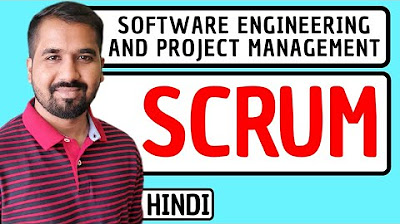Intro to Scrum in Under 10 Minutes
Summary
TLDRHamid Shojaee's video script introduces Scrum as an agile development method, emphasizing its efficiency and practicality. Key concepts like product backlogs, user stories, team roles including the Scrum Master and Product Owner, sprints, and burndown charts are covered. The script outlines the Scrum process from planning to execution, highlighting tools like burndown charts for project visibility and daily Scrum meetings for team synchronization. The video concludes with a pitch for the OnTime tool, developed by the speaker, designed to facilitate Scrum implementation.
Takeaways
- 🔹 Scrum is an agile development practice that focuses on iterative progress and collaboration.
- 📝 Product backlogs are collections of user stories representing desired features from various stakeholders.
- 👤 Key roles in Scrum include the Product Owner, who represents users and sets product direction, and the Scrum Master, who facilitates the process.
- 👥 The development team includes various members responsible for building, testing, and using the product.
- 📈 Release planning involves selecting user stories for a release and estimating the work involved.
- 📊 Burndown charts are essential tools for visualizing project progress and ensuring smooth development.
- 🔢 Estimations can be made in story points or hours, with a standardized approach to ensure consistency.
- 🏃 Sprints are short, fixed-length periods where a subset of the release backlog is developed to a ship-ready state.
- 📅 The goal of each sprint is to complete all planned features, with a burndown chart tracking progress towards this goal.
- 🤝 Daily Scrum meetings facilitate communication, ensuring the team is aligned and addressing any obstacles promptly.
- 🔄 Sprint Retrospectives are held at the end of each sprint to reflect on successes and areas for improvement.
Q & A
What is Scrum and why is it considered a great agile development practice?
-Scrum is an agile development framework that emphasizes incremental and iterative work towards completing a project. It is considered great because it promotes flexibility, transparency, and efficiency in software development processes.
What are the core Scrum concepts covered in the video?
-The core Scrum concepts covered include product backlogs, team roles, sprints, burndown charts, and daily Scrum meetings.
What is a product backlog in Scrum?
-A product backlog is a list of features, or user stories, that represent all the things that could make the product better. It acts as a wish list for the product.
What is the role of the product owner in Scrum?
-The product owner represents the users and customers, ensuring the right features make it into the product backlog and setting the direction of the product.
What is the role of the Scrum Master?
-The Scrum Master ensures the project progresses smoothly and that every team member has the tools they need to complete their work. They facilitate meetings and release planning.
How are user stories prioritized and estimated in Scrum?
-User stories are prioritized based on their importance and estimated in terms of the amount of work involved. Larger stories may be broken down into smaller chunks for easier estimation.
What is a sprint in Scrum and what is its purpose?
-A sprint is a short-duration milestone where a team tackles a manageable chunk of the project to get it to a ship-ready state. The purpose of each sprint is to complete a subset of the release backlog.
Why is the burndown chart important in Scrum?
-The burndown chart is important because it provides a daily measure of the remaining work in a sprint, helping the team to monitor progress and adjust the project schedule if needed.
What is Burndown Velocity and how is it calculated?
-Burndown Velocity is the average rate of productivity for the team, calculated by the slope of the burndown chart, which shows the rate at which work is being completed each day.
What happens during a Daily Scrum meeting?
-During a Daily Scrum meeting, team members quickly list the work they completed since the last meeting and any obstacles they are facing to ensure the team stays in sync and issues are addressed promptly.
What is the purpose of a Sprint Retrospective meeting?
-The purpose of a Sprint Retrospective meeting is for the team to reflect on what went well and areas for improvement after each sprint, allowing for continuous improvement in the Scrum process.
What is the tool mentioned in the video for implementing Scrum?
-The tool mentioned in the video for implementing Scrum is called OnTime, which helps manage products, backlogs, teams, releases, and sprints, and provides project visibility with burndown charts.
Outlines

Dieser Bereich ist nur für Premium-Benutzer verfügbar. Bitte führen Sie ein Upgrade durch, um auf diesen Abschnitt zuzugreifen.
Upgrade durchführenMindmap

Dieser Bereich ist nur für Premium-Benutzer verfügbar. Bitte führen Sie ein Upgrade durch, um auf diesen Abschnitt zuzugreifen.
Upgrade durchführenKeywords

Dieser Bereich ist nur für Premium-Benutzer verfügbar. Bitte führen Sie ein Upgrade durch, um auf diesen Abschnitt zuzugreifen.
Upgrade durchführenHighlights

Dieser Bereich ist nur für Premium-Benutzer verfügbar. Bitte führen Sie ein Upgrade durch, um auf diesen Abschnitt zuzugreifen.
Upgrade durchführenTranscripts

Dieser Bereich ist nur für Premium-Benutzer verfügbar. Bitte führen Sie ein Upgrade durch, um auf diesen Abschnitt zuzugreifen.
Upgrade durchführenWeitere ähnliche Videos ansehen

Scrum Explained in Hindi l Software Engineering and Project Management Course

Sprints - The Biggest Mistake Of Software Engineering

Scrum vs Agile: Key Differences Simplified! 🚀 | KnowledgeHut

Agile business transformation: what it takes to succeed | Joe Justice | TEDxSeattleSalon

TERBARU - Materi & Soal SKB Penata Kelola Sistem dan TI - Pengembangan Agile & Metodologi SCRUM

What's the Difference Between Scrum and Agile?
5.0 / 5 (0 votes)
